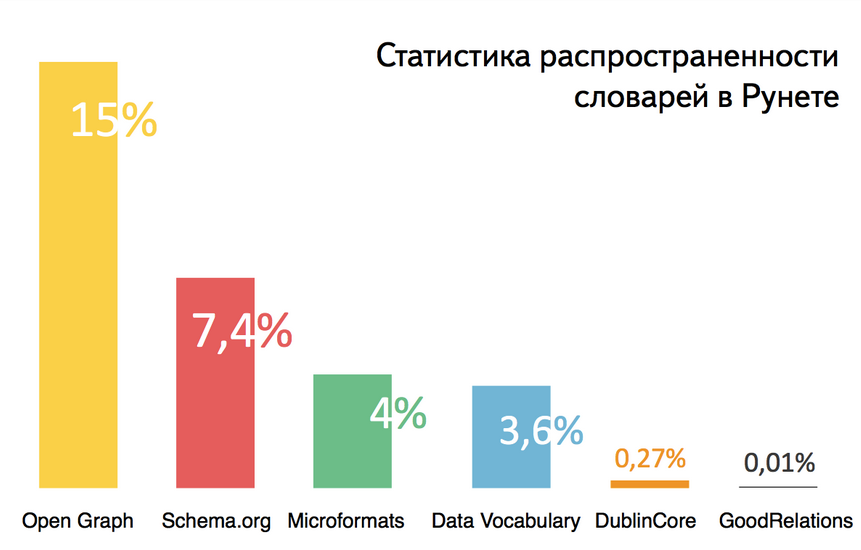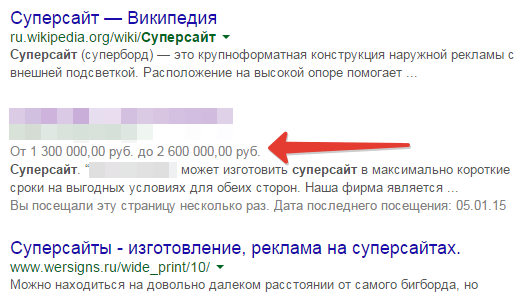The practice of using semantic markup
Recently, in the world of seo, the use of micro-marking (semantic markup) for various purposes is becoming more and more popular. Although micro-marking began to be used several years ago, now we are witnessing its active development both in Yandex and in Google. This is confirmed by the latest publications on the Yandex blog for webmasters: “Microdistribution for large sites” and “Commodity snippets for an online store” .
Google is also engaged in this area, an example of which is the refinement of snippets in the main issue, which will be discussed later in this publication.
The main purpose of micro-marking is to provide structured data to a search engine about a product / service or any other material posted on a page. Using semantic markup, it has become possible to highlight important information on a page, to delimit and structure content by type. Search engines easily understand this, they provide the user with exactly the information about the page that you want to convey .
Each micro-layout has its own dictionary (a certain base of various commands, classes, subclasses), which it understands and is able to process correctly. Dictionaries are quite extensive, but the entire library can be found on specialized sites (the article provides links to libraries for the most popular).

(Data for 2014)
Consider the main types of semantic markup:
1. Open Graf
2. Data Vocabulary
3. Schema.org
4. UTF characters
Open Graf is used to create informative links for transmission on social networks. That is, it is possible to enter the desired text and image on your own, so that users, clicking on the like, distribute your content in the most presentable way.
Initially, Open Graf was created specifically for Facebook, but now many social networks support this micro-layout.
On CMS Word Press there is a free plugin for marking Open Graf on the pages of the site. Many leading SEO bloggers use Open Graf. Here is one such example. Informative content is displayed when you click on the page:

A complete guide to use can be found on the Yandex website.
Data Vocabulary, far from leading markup, is used much less often than its counterparts, but, in my opinion, it is one of the best dictionaries in its class (especially for Google), since it really allows you to highlight the snippet against the background of competitors.
An organic link on Google stands out, as there is already information on product prices

in the search results: In my opinion, this is another way to increase the CTR of a search link. A serious minus is that Yandex does not understand this markup.
Now the development of the Data Vocabulary format has been suspended, since all efforts are directed to Schema.org , but until now Google understands this markup and handles it perfectly.
Complete Guide for Data Vocabulary.
The most common micro-markup, about which there is a lot of information on the Yandex blog. I would like to especially highlight its application for commercial seo:
a) Page layout - Contacts for a commercial site (the rules for filling are in the same Yandex blog):

b) markup of product snippets for the store, which was introduced at the end of 2014.
The user is immediately given a brief information about the parameters of the product, as well as its price:

In order to view micro-marking as a Yandex search robot, I recommend using the micro-marking validator .
A detailed guide to using Schema org.
UTF characters (★ ☒) are not micro-markup per se, but in general, from the point of view of seo, they have the same goal as semantic markup - to increase the CTR of a search link. Therefore, it is worth considering this in this publication.
The logic is simple: we use short descriptions (preferably no more than 160 characters) and add any UTF characters to them that will improve the attractiveness of the link. Today, there are more than 100 different characters.
According to my research, Google in 85% of cases processes these characters. Yandex does this very rarely, but if you manage to get such an attractive snippet, then the CTR starts to grow very much, especially for 1 page of output. This is a huge bonus against competitors.
For example, for a query - “LED chandeliers”, all sites from TOP-3 on Google use UTF characters:

Semantic markup is a promising direction. This publication examined its use for commercial seo, namely, for raising the CTR of a link in organic search . There are no in-depth details of the code, but ready-made examples are given in the form in which the user sees them, and which really work in practice.
If the topic is really interesting, then the detailed use of a particular format can easily be studied by clicking on the links above.
Google is also engaged in this area, an example of which is the refinement of snippets in the main issue, which will be discussed later in this publication.
The purpose of semantic markup
The main purpose of micro-marking is to provide structured data to a search engine about a product / service or any other material posted on a page. Using semantic markup, it has become possible to highlight important information on a page, to delimit and structure content by type. Search engines easily understand this, they provide the user with exactly the information about the page that you want to convey .
Each micro-layout has its own dictionary (a certain base of various commands, classes, subclasses), which it understands and is able to process correctly. Dictionaries are quite extensive, but the entire library can be found on specialized sites (the article provides links to libraries for the most popular).

(Data for 2014)
Consider the main types of semantic markup:
1. Open Graf
2. Data Vocabulary
3. Schema.org
4. UTF characters
1. Open Graf
Open Graf is used to create informative links for transmission on social networks. That is, it is possible to enter the desired text and image on your own, so that users, clicking on the like, distribute your content in the most presentable way.
Initially, Open Graf was created specifically for Facebook, but now many social networks support this micro-layout.
On CMS Word Press there is a free plugin for marking Open Graf on the pages of the site. Many leading SEO bloggers use Open Graf. Here is one such example. Informative content is displayed when you click on the page:

A complete guide to use can be found on the Yandex website.
2. Data Vocabulary
Data Vocabulary, far from leading markup, is used much less often than its counterparts, but, in my opinion, it is one of the best dictionaries in its class (especially for Google), since it really allows you to highlight the snippet against the background of competitors.
An organic link on Google stands out, as there is already information on product prices

in the search results: In my opinion, this is another way to increase the CTR of a search link. A serious minus is that Yandex does not understand this markup.
Now the development of the Data Vocabulary format has been suspended, since all efforts are directed to Schema.org , but until now Google understands this markup and handles it perfectly.
Complete Guide for Data Vocabulary.
3. Schema org
The most common micro-markup, about which there is a lot of information on the Yandex blog. I would like to especially highlight its application for commercial seo:
a) Page layout - Contacts for a commercial site (the rules for filling are in the same Yandex blog):

b) markup of product snippets for the store, which was introduced at the end of 2014.
The user is immediately given a brief information about the parameters of the product, as well as its price:

In order to view micro-marking as a Yandex search robot, I recommend using the micro-marking validator .
A detailed guide to using Schema org.
4. UTF characters
UTF characters (★ ☒) are not micro-markup per se, but in general, from the point of view of seo, they have the same goal as semantic markup - to increase the CTR of a search link. Therefore, it is worth considering this in this publication.
The logic is simple: we use short descriptions (preferably no more than 160 characters) and add any UTF characters to them that will improve the attractiveness of the link. Today, there are more than 100 different characters.
According to my research, Google in 85% of cases processes these characters. Yandex does this very rarely, but if you manage to get such an attractive snippet, then the CTR starts to grow very much, especially for 1 page of output. This is a huge bonus against competitors.
For example, for a query - “LED chandeliers”, all sites from TOP-3 on Google use UTF characters:

Semantic markup is a promising direction. This publication examined its use for commercial seo, namely, for raising the CTR of a link in organic search . There are no in-depth details of the code, but ready-made examples are given in the form in which the user sees them, and which really work in practice.
If the topic is really interesting, then the detailed use of a particular format can easily be studied by clicking on the links above.
